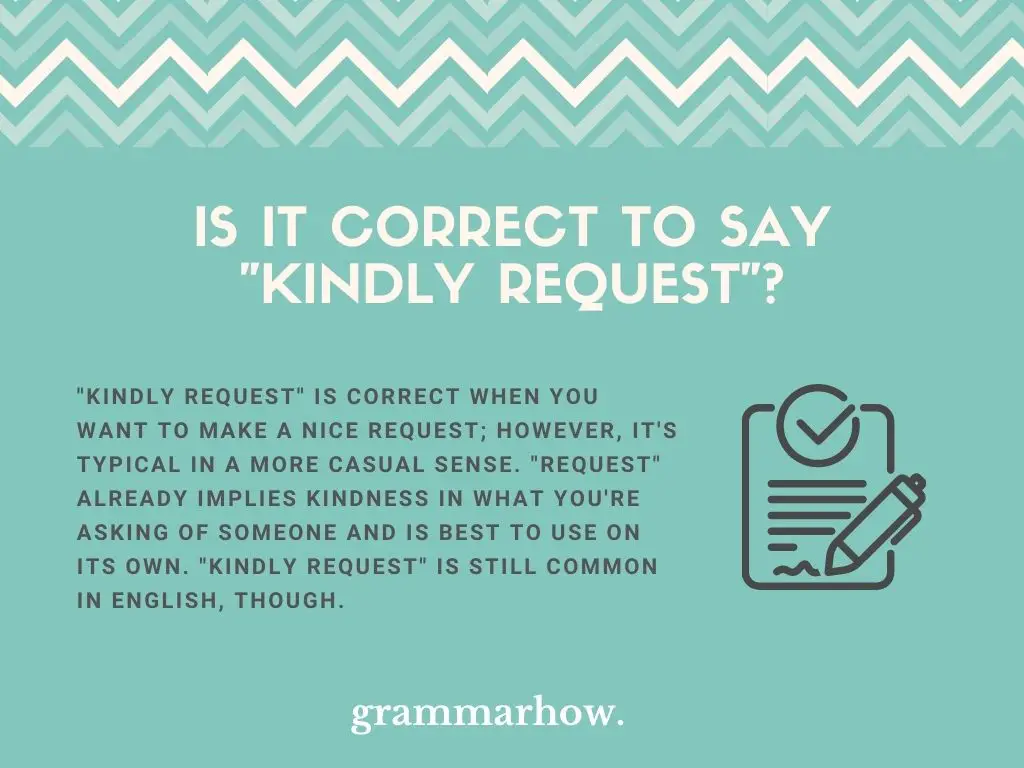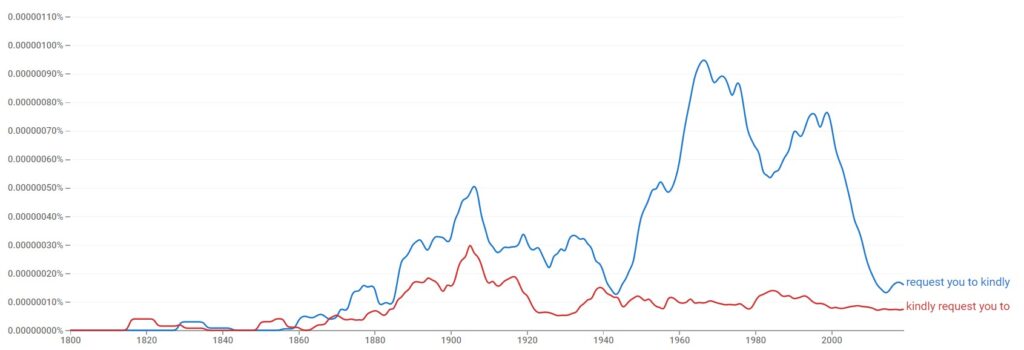Any form of request in English follows a certain set of rules. Generally, those rules are overlooked by native speakers, and phrases like “kindly request” begin to appear. This article will look at whether it’s correct and how to use “request” appropriately.
Is It Correct To Say “Kindly Request”?
“Kindly request” is correct when you want to make a nice request; however, it’s typical in a more casual sense. “Request” already implies kindness in what you’re asking of someone and is best to use on its own. “Kindly request” is still common in English, though.

The definition of “request,” according to The Cambridge Dictionary, is “to ask for something politely or officially.”
Since the meaning of “request” includes “polite” in it, we’re already assuming that the “request” is “kind,” and thus “kindly request” is a redundant construct. Still, many formal writers use it to show that they’re being as polite as possible with their requests.
Should I Use “I Request You” Instead Of “I Kindly Request You”?
The phrase “I request you” is incorrect, but so is the phrase “I kindly request you.” We don’t use a pronoun after the verb “request.” Instead, we use “that” and then the pronoun.” “I request you” is still more appropriate than “I kindly request you,” though.
If you’re feeling a little confused, don’t worry. We’ll talk you through what we mean with the help of some examples.
- Correct:I request that you meet me in my office.
- Incorrect:I request you meet me in my office.
- Correct:I kindly request that you don’t do that again.
- Incorrect:I kindly request you don’t do that again.
We must include “that” after “request” if we want to remain grammatically correct. If we’re following the official language rules of English, then “request that you” is always the answer.
However, like many other rules in English, native speakers don’t always follow them if they believe them to be unnecessary.
This article aims to teach you what is grammatically correct. In this sense, it is grammatically correct to write:
- I request that you stop immediately.
However, many native speakers will also say and write the following:
- I request you stop immediately.
- I request you to stop immediately.
Grammatically speaking, both of these sentence constructs are wrong because they don’t follow the rules of how “request” affects a sentence. Still, no native speakers see a problem with it and will happily use it whenever it suits them.
You can apply the same logic to your own use of the English language. If it feels more appropriate to use “I request you,” then you may do so. However, it’s best left for informal and casual situations over anything else.
Is It More Correct To Use “Request You To Kindly”?
Let’s look at some comparisons between a few common phrases you might use. Again, “request you” isn’t necessarily correct, but more often than not, native speakers will use it in this way, so you can do so as well.
According to this graph, “request you to kindly” is more popular than “kindly request you to.” We like to add the adverb at the end of the introductory clause because it helps with the flow of the sentence.

As of this year, both phrases are fairly close in usage. However, if we look at the difference between the 1960s and 2000s, it’s clear that “request you to kindly” was the most popular choice of the two. It’s only recently that many people have used both in an equal fashion.
As we said, it’s likely because people like to include the adverb at the end of the clause, as follows:
- I request you to kindly stop doing that.
Rather than:
- I kindly request you to stop doing that.
Some writers will go even further and write the following:
- I request you to stop doing that kindly.
This way, the adverb “kindly” is at the very end of the sentence rather than just at the end of the “request” verb portion. Either way, the meaning is the same for all three of the above sentences.
Should I Use “I Kindly Request That You” Instead Of “I Kindly Request You To”?
We mentioned earlier that we should use “that” between the “request” and the “pronoun” if we want to remain grammatically correct. We also said that not many native speakers do this, and it’s unlikely you will need to.
We now have the statistics to show you just how similar using the phrases “I kindly request that you” and “I kindly request you to” are.
This graph shows that both phases are almost identical today. While there has been some drastic variation over the last two centuries, “I kindly request that you” is only slightly above “I kindly request you to” today.

As you can see, native speakers can sometimes ignore the grammatically correct sentences and phrases to give way to the more familiar and comfortable ones.
Typically, if we write a verb in a sentence, we want to include the pronoun straight after it. That’s the way for most verbs in English, and yet “request” asks for us to include “that” as an extra step.
Naturally, many native speakers overlook this step for ease of writing. It’s clear that the grammatically correct line between the two has blurred. Now, both phrases are correct to use.
While “I kindly request you to” might not be officially recognized, it’s only a matter of time before dictionaries start to include it as an official and correct sentence structure.
Can “Request” And “Ask” Be Used Interchangeably?
Generally, “ask” is an easier verb to use than “request.” It doesn’t work with the same grammatical restrictions, which makes a lot of native speakers more attracted to using it.
“Request” and “ask” are interchangeable. We use both to ask somebody a question or to get them to do something for you. However, “request” implies politeness, while “ask” is simply an order. You have to say “ask politely” to make it the same as a “request.”
Typically, the language and sentence structures that come from “ask” are much easier to manage. We can simply replace “request” in any of the sentences below:
- I request that you don’t do that.
- I ask that you don’t do that.
- I request you to stop now, please.
- I ask you to stop now, please.
- I requested you to do this for me.
- I asked you to do this for me.
As you can see, while “request you” isn’t grammatically correct (although it’s common to use), “ask you” is grammatically correct because it follows standard verb rules. That’s why many native speakers prefer using “ask” to “request.”
As we said, though, “ask” isn’t nearly as polite as “request.” For example:
- I request that you change your attire.
- I ask that you change your attire.
“Request” is polite. We’re kindly asking somebody to do something, even if they might not be too happy with doing it. However, “ask” isn’t nearly as polite, and in this case, we might be seen as rude for saying it. Instead, we should write:
- I politely ask that you change your attire.
- I kindly ask that you change your attire.
How Do You Kindly Request Something In An Email?
Let’s go over some email examples of how we might kindly make a request. We’ll include everything we’ve mentioned so far in this article, so make sure you’re paying attention.
- Dear sir,
- I’d like to kindly request that you change the work rota for the coming week.
- I’m unfortunately not able to make it in for my scheduled hours.
- Kind regards,
- Jeremy Smythe
- Dear ma’am,
- I request that you attend this meeting on Friday kindly.
- Please bring your presentation with you as well.
- Kind regards,
- Mr. Stevens
To make a request in an email, we can write in the above ways. Typically, if we’re requesting a superior to do something for us (like in the first example with the work rota), it will help to include a reason why you need the request completed.
It’s not wise to request something from your boss if you don’t have a valid reason for doing so.
How Do You Kindly Ask For Something?
“Asking kindly” is very similar to requesting, but we need to include an extra adverb to indicate that we are being polite. “Asking” on its own is fairly rude, and you don’t want your work emails to come across as rude.
- Dear Mr. Stevens,
- I’d like to politely ask you to meet me later today to discuss my latest findings.
- I think I’m on to something here and could do with outside input.
- Kind regards,
- Mrs. Peacock
- Dear John Penson
- I ask you to kindly put away your equipment at the end of the day.
- It causes a hazard for the people in the room after you’re done with it, and I don’t want an accident to occur.
- I hope you can action this soon,
- Mr. James
We can ask something kindly by using an adverb like “kindly” or “politely” in the email. Again, we don’t want to ask our bosses or superiors anything like this without a valid reason for doing so.
